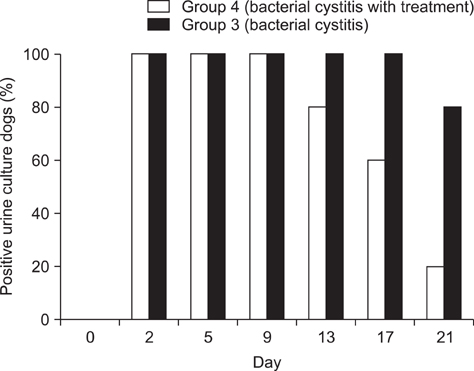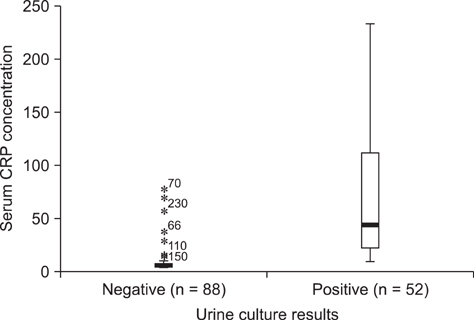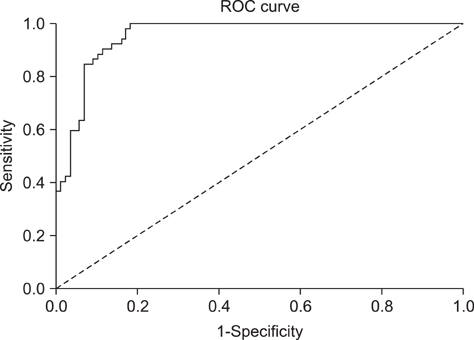J Vet Sci.
2012 Jun;13(2):179-185. 10.4142/jvs.2012.13.2.179.
C-reactive protein as an indicator of inflammatory responses to experimentally induced cystitis in dogs
- Affiliations
-
- 1Department of Veterinary Internal Medicine, College of Veterinary Medicine, Chungnam National University, Daejeon 305-764, Korea.
- 2Department of Veterinary Internal Medicine, College of Veterinary Medicine, Seoul National University, Seoul 151-742, Korea. hyyoun@snu.ac.kr
- 3Research Institute and BK21 Program for Veterinary Science, College of Veterinary Medicine, Seoul National University, Seoul 151-742, Korea.
- 4Department of Veterinary Clinical Pathology, College of Veterinary Medicine, Seoul National University, Seoul 151-742, Korea.
- KMID: 1376192
- DOI: http://doi.org/10.4142/jvs.2012.13.2.179
Abstract
- The aim of this study was to demonstrate and assess C-reactive protein (CRP) changes in dogs with induced bacterial cystitis with or without antibiotics. We also evaluated availability of CRP levels to serve as an indicator for monitoring or diagnosing bacterial cystitis. Serial CRP concentrations in dogs with induced bacterial cystitis were higher than those of controls (p < 0.001). CRP concentrations peaked on day 7 and gradually decreased thereafter. In the treatment group, CRP concentrations decreased after medication compared to the untreated group (p = 0.032). CRP levels had a linear correlation with urine white blood cell counts among all groups (r = 0.837, p < 0.001, n = 140). Compared to the negative urine culture group, dogs with positive urine culture results had higher CRP concentrations (median 43.8 mg/L vs. 5.9 mg/L; p < 0.001). Area under the receiver operating characteristic curve was 0.955; when cut-off value was 12.2 mg/L, CRP measurements were found to have a sensitivity of 92.3% and specificity of 86.4%. This result indicates that rapid increases of CRP occurred after inducing bacterial cystitis and CRP may be a useful indicator for monitoring or diagnosing canine bacterial cystitis together with sediment urinalysis and urine bacterial culture.
MeSH Terms
-
Amoxicillin-Potassium Clavulanate Combination/therapeutic use
Animals
Anti-Bacterial Agents/therapeutic use
C-Reactive Protein/genetics/*metabolism
Cystitis/metabolism/*veterinary
Dogs
Gene Expression Regulation/*physiology
Inflammation/*metabolism
Male
Proteus Infections/drug therapy/metabolism/microbiology/*veterinary
Proteus mirabilis
Figure
Reference
-
1. Barsanti JA. Green CE, editor. Genitourinary infections. Infectious Disease of the Dogs and Cat. 1998. 2nd ed. Philadelphia: Saunders;626–645.2. Bartges JW. Ettinger SJ, Feldman EC, editors. Urinary tract infections. Textbook of Veterinary Internal Medicine: Diseases of the Dog and Cat. 2005. 6th ed. St. Louis: Elsvier Saunders;1800–1808.3. Bowles MH, Welsh RD, Hoffman J, Turnwald GH. Evaluation of a method using Proteus mirabilis and Pseudomonas aeruginosa to experimentally induce dual infection of the urinary bladder in dogs. Am J Vet Res. 2000. 61:1484–1486.
Article4. Burton SA, Honor DJ, Mackenzie AL, Eckersall PD, Markham RJ, Horney BS. C-reactive protein concentration in dogs with inflammatory leukograms. Am J Vet Res. 1994. 55:613–618.5. Canova CR, Courtin C, Reinhart WH. C-reactive protein (CRP) in cerebro-vascular events. Atherosclerosis. 1999. 147:49–53.
Article6. Cerón JJ, Eckersall PD, Martínez-Subiela S. Acute phase proteins in dogs and cats: current knowledge and future perspectives. Vet Clin Pathol. 2005. 34:85–99.
Article7. Conner JG, Eckersall PD, Ferguson J, Douglas TA. Acute phase response in the dog following surgical trauma. Res Vet Sci. 1988. 45:107–110.
Article8. Dąbrowski R, Wawron W, Kostro K. Changes in CRP, SAA and haptoglobin produced in response to ovariohysterectomy in healthy bitches and those with pyometra. Theriogenology. 2007. 67:321–327.
Article9. Fransson BA, Karlstam E, Bergstrom A, Lagerstedt AS, Park JS, Evans MA, Ragle CA. C-reactive protein in the differentiation of pyometra from cystic endometrial hyperplasia/mucometra in dogs. J Am Anim Hosp Assoc. 2004. 40:391–399.
Article10. Garin EH, Olavarria F, Araya C, Broussain M, Barrera C, Young L. Diagnostic significance of clinical and laboratory findings to localize site of urinary infection. Pediatr Nephrol. 2007. 22:1002–1006.
Article11. Gewurz H, Mold C, Siegel J, Fiedel B. C-reactive protein and the acute phase response. Adv Intern Med. 1982. 27:345–372.12. Huang DT, Huang FY, Tsai TC, Tsai JD, Chiu NC, Lin CC. Clinical differentiation of acute pyelonephritis from lower urinary tract infection in children. J Microbiol Immunol Infect. 2007. 40:513–517.13. Isaacman DJ, Burke BL. Utility of the serum C-reactive protein for detection of occult bacterial infection in children. Arch Pediatr Adolesc Med. 2002. 156:905–909.
Article14. Jergens AE, Schreiner CA, Frank DE, Niyo Y, Ahrens FE, Eckersall PD, Benson TJ, Evans R. A scoring index for disease activity in canine inflammatory bowel disease. J Vet Intern Med. 2003. 17:291–297.
Article15. Jodal U, Lindberg U, Lincoln K. Level diagnosis of symptomatic urinary tract infections in childhood. Acta Paediatr Scand. 1975. 64:201–208.
Article16. Lees GE. Bacterial urinary tract infections. Vet Clin North Am Small Anim Pract. 1996. 26:297–304.
Article17. Mitchell KD, Kruth SA, Wood RD, Jefferson B. Serum acute phase protein concentrations in dogs with autoimmune hemolytic anemia. J Vet Intern Med. 2009. 23:585–591.
Article18. Mold C, Du Clos TW, Nakayama S, Edwards KM, Gewurz H. C-reactive protein reactivity with complement and effects on phagocytosis. Ann N Y Acad Sci. 1982. 389:251–262.
Article19. Mold C, Rodriguez W, Rodic-Polic B, Du Clos TW. C-reactive protein mediates protection from lipopolysaccharide through interactions with FcγR. J Immunol. 2002. 169:7019–7025.
Article20. Naseri M. Alterations of peripheral leukocyte count, erythrocyte sedimentation rate, and C-reactive protein in febrile urinary tract infection. Iran J Kidney Dis. 2008. 2:137–142.21. Nielsen L, Toft N, Eckersall PD, Mellor DJ, Morris JS. Serum C-reactive protein concentration as an indicator of remission status in dogs with multicentric lymphoma. J Vet Intern Med. 2007. 21:1231–1236.
Article22. Ohno K, Yokoyama Y, Nakashima K, Setoguchi A, Fujino Y, Tsujimoto H. C-reactive protein concentration in canine idiopathic polyarthritis. J Vet Med Sci. 2006. 68:1275–1279.
Article23. Osborne CA, Lees GE. Osborne CA, Finco DR, editors. Bacterial infections of the canine and feline urinary tract. Canine and Feline Nephrology and Urology. 1995. 1st ed. Baltimore: Williams & Wilkins;759–797.24. Otabe K, Ito T, Sugimoto T, Yamamoto S. C-reactive protein (CRP) measurement in canine serum following experimentally-induced acute gastric mucosal injury. Lab Anim. 2000. 34:434–438.
Article25. Padilla J, Osborne CA, Ward GE. Effects of storage time and temperature on quantitative culture of canine urine. J Am Vet Med Assoc. 1981. 178:1077–1081.26. Pulliam PN, Attia MW, Cronan KM. C-reactive protein in febrile children 1 to 36 months of age with clinically undetectable serious bacterial infection. Pediatrics. 2001. 108:1275–1279.
Article27. Rush JE, Lee ND, Freeman LM, Brewer B. C-reactive protein concentration in dogs with chronic valvular disease. J Vet Intern Med. 2006. 20:635–639.
Article28. Senior DF, Gaskin JM, Buergelt CD, Harvey JW, Keefe TJ. Amoxicillin and clavulanic acid combination in the treatment of experimentally induced bacterial cystitis in dogs. J Am Anim Hosp Assoc. 1986. 22:227–233.29. Shaw KN, Gorelick M, McGowan KL, Yakscoe NM, Schwartz JS. Prevalence of urinary tract infection in febrile young children in the emergency department. Pediatrics. 1998. 102:e16.
Article30. Specht A, Chan D, O'Toole T, Kent M, Benson J, Rozanski EA, Rush JE. Acute staphylococcal peritonitis following cystocentesis in a dog. J Vet Emerg Crit Care. 2002. 12:183–187.
Article31. Turnwald GH, Gossett KA, Cox HU, Kearney MT, Roy AF, Thomas DE, Troy GC. Comparison of single-dose and conventional trimethoprim-sulfadiazine therapy in experimental Staphylococcus intermedius cystitis in the female dog. Am J Vet Res. 1986. 47:2621–2623.32. Yamamoto S, Shida T, Miyaji S, Santsuka H, Fujise H, Mukawa K, Furukawa E, Nagae T, Naiki M. Changes in serum C-reactive protein levels in dogs with various disorders and surgical traumas. Vet Res Commun. 1993. 17:85–93.
Article33. Yamashita K, Fujinaga T, Miyamoto T, Hagio M, Izumisawa Y, Kotani T. Canine acute phase response: relationship between serum cytokine activity and acute phase protein in dogs. J Vet Med Sci. 1994. 56:487–492.
Article
- Full Text Links
- Actions
-
Cited
- CITED
-
- Close
- Share
- Similar articles
-
- Comparison of post-operative C-reactive protein levels between elective general and orthopedic surgery in dogs
- Effects of Extracorporeal Shock Wave Lithortripsy Experimentally Induced Cholelithiasis and Organs in the Dog
- Treatment of radiation-induced cystitis with hyperbaric oxygen
- Eosinophilic cystitis
- Penicillin G-induced hemorrhagic cystitis





